Chapter 2: Analyzing and Discussing African Art
Chapter 2.3 “Rules” for Traditional African Art
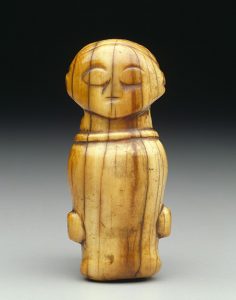
Africa is immensely varied in visual expression. Even though our course concentrates on art south of the Sahara desert (with one upcoming exception), the variety of traditional art is still immense. Nonetheless, a group of traits applies generally to most figurative African traditional art. When these rules are broken, which sometimes happens, it is noteworthy.
Human-Centered
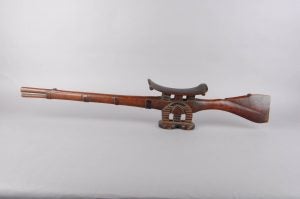
Traditional African art is human-centered. This is true even in abstract terms: body arts are by definition concerned directly with human beings, structures are built on a human scale, textiles are meant to wrap around a person or decorate their environment, pots are meant for their direct use. Many utilitarian objects that require no ornamentation–combs, cups, spoons, whistles (Fig. 123)–are nonetheless ornamented with human faces or bodies. In figurative terms, it is clear that most traditional African representations typically depict one of two things: human beings or animals. Landscape references do not exist, for the most part, nor does still life imagery of inanimate objects or flowers and fruit. When such portrayals occur, these exceptions deserve comment (Fig. 124).
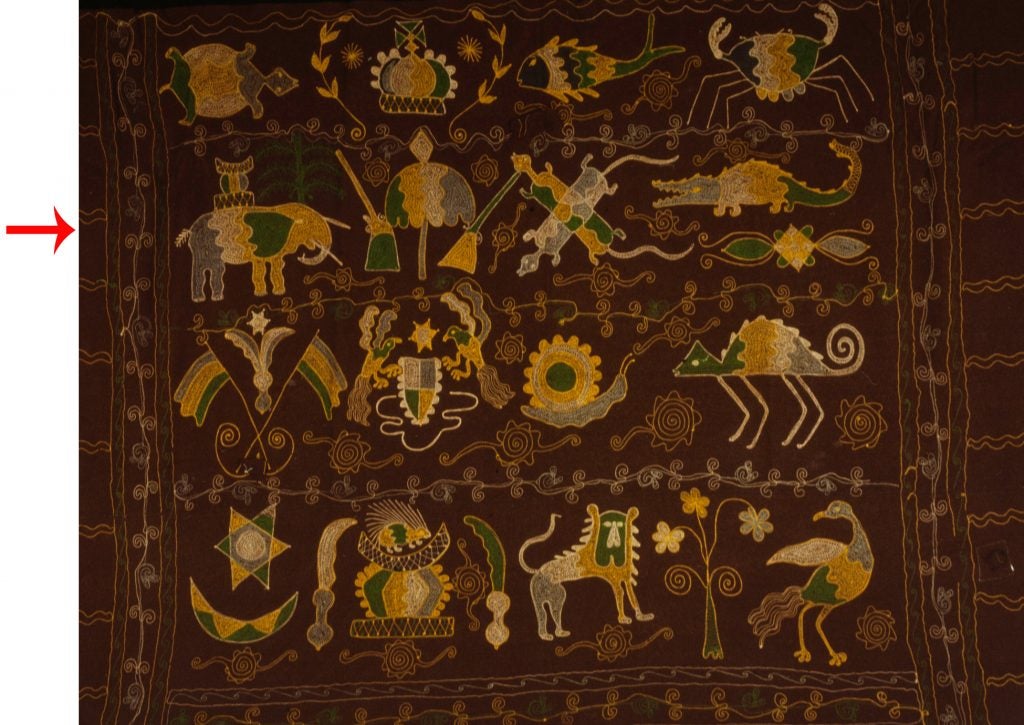
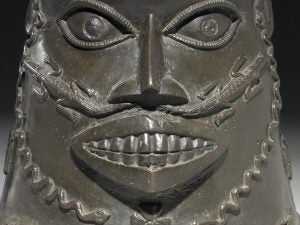
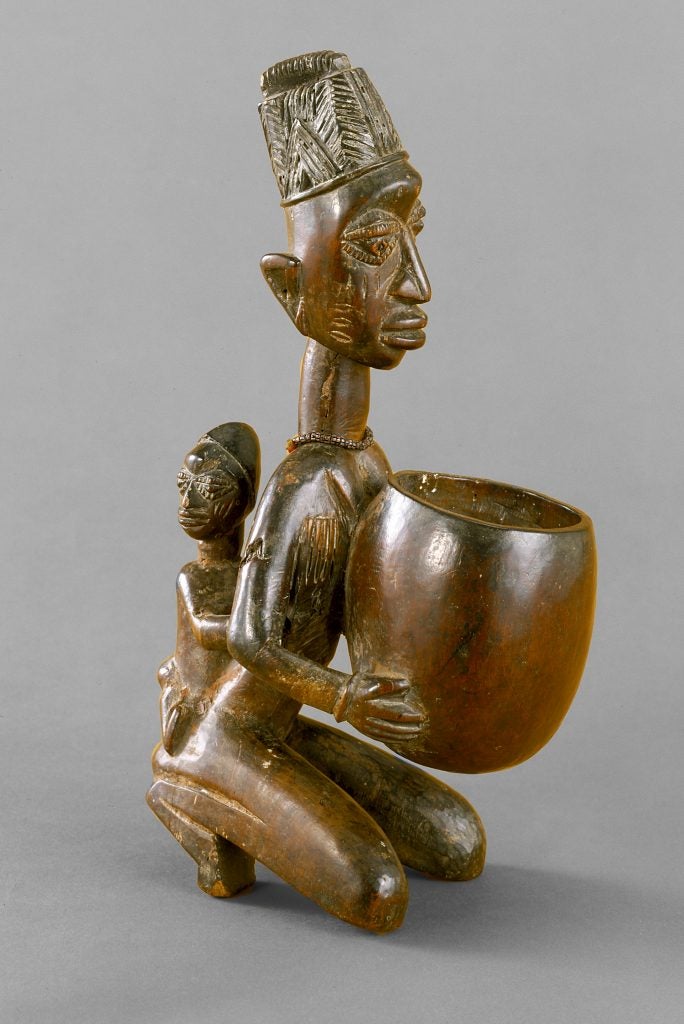
This concentration on the human form (even if it represents spirits or deities, which it sometimes does) is greater than what is found in most parts of world art history. When animals appear, they are rarely just allusions to the human habitat. While they can represent simple game in a hunting society, they are more likely metaphors for certain types of human beings or for human traits. Leopards and elephants, for example, often relate to rulership or leadership, because of their deadliness or power, respectively. They are not simply observed animals who happen to appear locally. Many of these are part of the verbal world featuring in commonly-used proverbs that make their visual occurrences easily interpretable to their audience. An Akan proverb from Ghana states, “No one following an elephant has to worry about vines catching him”, i.e. the elephant plows down all obstacles in its path. This refers to a chief or other powerful man, who clears the way for those who are attached to him. Because verbal references like this are part of the culture, representations of the elephant instantly call to mind the chief (Fig. 125).
One category of animals frequently occurs in art: the liminal animal. Liminality, in general, refers to a state of in-betweenness; the word’s Latin origin means “threshold,” and defines a state that is between two defined identities. In the insect world, a caterpillar and a butterfly are two distinct identities of one insect, and the cocoon marks its liminal state. In African cultural life, some societies mark the liminal state of man’s changing identities of child and adult with initiation, a period of transition and transformation. The liminal animal, however, is at a threshold of a different source. This is a class of animals that regularly lives in two distinct worlds. Some liminal animals commonly depicted in African art move between land and water, such as tortoises, crocodiles, pythons and other water snakes (not snakes in general), and mudfish, a catfish-related animal that can crawl on damp earth or survive in mud for extended periods. Others move between land and sky, such as most birds. Animals like this can represent people who move between the two worlds of humans and spirits, that is, priests/priestesses, ritual specialists (Fig. 126), monarchs, and witches.
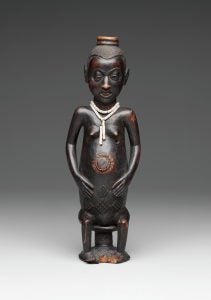
Frontality
Frontality refers to the position of the body in both two and three dimensions. In a frontal depiction, the head and spine are perfectly aligned in a straight line (Fig. 127). The position of arms and legs is immaterial, but the head cannot turn or tilt. This reinforces formality; it is a pose that artists have employed throughout world art’s history when representing deities and rulers. Frontality imbues a figure with a sense of permanence and dignity. The concept of frontality only applies to human beings, since animals’ heads and spines are not normally aligned, and it only refers to representations that at least include a torso; i.e. masks are not referred to as frontal.
In traditional African art, the non-frontal figure is usually negligible–a child (Fig. 128), a member of an entourage, or some lesser being. Even these individuals are usually depicted frontally, however.
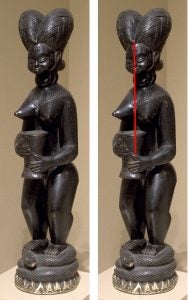
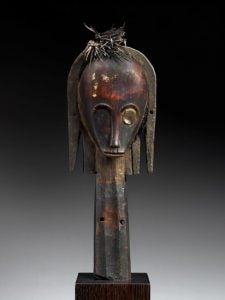
It’s vital to remember that photographers often prefer to take object photos from an angle, so a viewer’s immediate impression may not be that of frontality. If the alignment of facial features on a vertical axis conforms to the known line of the spine, however, discernment of frontality is easily achieved (Fig. 129).
Stillness
An emphasis on dignity and permanence also favors the representation of stillness in figurative art. Movement is temporary and implies some form of work, however tangential. Stillness underlines the innate qualities of an elevated being. Although the mother in Fig. 128 above is not quite frontal, since her head’s angle does not match that of her spine, she is shown in a still, kneeling position of maximum dignity.
Self-Composure (Expressionlessness)
With very few exceptions, traditional African art does not display human emotions. This is a reflection of desirable public display (a ruler at a festival, an initiation girl when presented to the public, a politician posing for a formal photograph). The ideal “face” is that of serene self-composure, unrocked by moods and reactions to others. This same ideal applies to artistic imagery. Figures normally have a restrained, dignified expression on their faces, without scowls or smiles (Fig. 130). When figures do show their teeth, it may be meant as an aggressive gesture (Fig. 126 above).
Ephebism

Ephebism refers to ideal age. Culturally, age is valued and venerated in Africa, with privileges not found among the young. Nonetheless, representations usually show individuals at a fully adult age that is still replete with physical vigor, yet without youthful recklessness–the maturity and power of someone in their early 30s. Even when a sculpture represents an elder, his face does not reflect his age. Instead, cultural cues (which vary according to ethnic group) may indicate advanced years. In Baule sculpture, for example, a beard is visual shorthand for an elder, yet the faces of bearded figures lack wrinkles or sagging skin (Fig. 130). Youthful musculature usually also marks the elder’s physique.
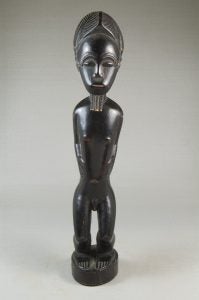
Hardly any artworks depict visible older individuals, but those rare instances that do are usually representations of those who lack social position and therefore do not need to be flattered. Conversely, although we see infants held by their mothers, older children cannot be distinguished. There are even times when infants are represented as adults because of ideal age–that is, in some West African cultures, twins who died in infancy are carved as fully grown adults, visually appeased by providing them with the bodies they never attained. (Fig. 131).
Abstraction
Most traditional African art avoids naturalism in favor of abstraction, although there is a full spectrum between the extremes of each. There are examples of naturalism, they are simply not standard (Fig. 132). Disinterest in realism often seems conceptual; over-sized heads on Yoruba figures, for example, exemplify philosophical underpinnings that equate the head with one’s destiny
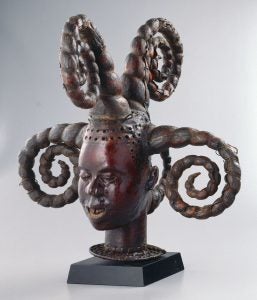
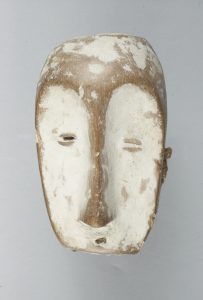
and worthy of honor. Quite a lot of African art is fairly naturalistic, even if exaggerations and distortions occur, but even extreme abstraction (Fig. 133) has identifiable characteristics that permit recognition of humanity.
Generic Physiognomy
When a traditional African artist creates a face, his training tends to ensure that face is consistent with other faces he makes. That is, learning how to make an eye, fashion a nose, or abstract an ear becomes habitual, and artists develop a “type” that they tend to reproduce instead of individualizing each face. Producing faces that resemble specific individuals is extremely rare; rather, generic physiognomy is the rule. This tends to work hand-in-hand with abstraction, but is evident even in fairly naturalistic works.
While the apprenticeship system partially explains this approach, it may not be the whole story. Avoidance of specificity may have its distant origins in concerns that reproducing someone’s face might have nefarious origins, meant to control them or cause harm.
Hieratic Scale
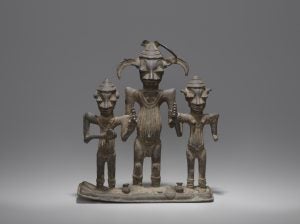
Scale, as we’ve previously discussed, relates to relative size, while hierarchy is a social sorting system–some people are at the top, others in the middle, with still others at the bottom. In art, hieratic scale or hierarchical scale or social scale all mean the same thing: figures whose size indicates their relative social standing. This concept applies only when we aren’t looking at single figures. A size relationship must be present, and this cannot be a natural size relationship–babies are naturally smaller than adults, and this does not reflect their social status. Under hieratic scale, three figures of varying heights in an artwork do not indicate three figures who happen to be taller or shorter than each other. Instead, the largest figure is the most important, while the middle one is of lesser significance and the smallest are inconsequential in comparison. This is determined by rank (Fig. 134), rather than individual worth or age; the child of an important figure might be rendered larger than a member of that figure’s entourage, despite a reverse height disparity in actual life.
Distorted Body Proportion
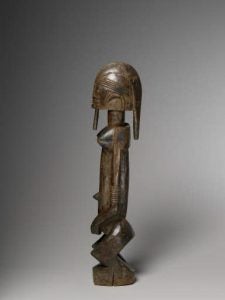
Abstraction in African art often means the exaggeration or distortion of one or more aspects of the body. Some Chokwe figures, for example, have enormous hands and feet. Dogon sculpture can have extremely elongated necks and/or torsos (Fig. 135), or Chamba figures may have shoulders that push forward in an unnatural manner (Fig. 136).
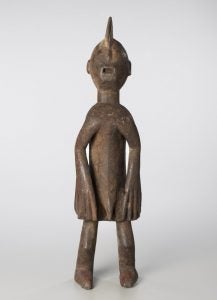

These are all distortions of the natural body and aspects of style that deserve mention, as are over- or undersized facial features. One of the most notable proportional distortions is that of the head to the body: that is, the head is often significantly oversized in African sculpture and can sometimes be undersized–but it is extremely rare for the head-to-body relationship to be represented naturalistically. What are natural head-to-body proportions in an adult (children, whose heads tend to be larger in relation to their bodies than those of adults, are not part of this equation)? They tend to be fairly consistent, despite variations in height, and are expressed in a mathematical ratio. That ratio is expressed as 1:x, with one representing the measurements of the person’s head, and x representing their height with the head as a unit. How many heads high is that person is the germane question, with the head measured from chin to top, discounting beards, hats, and coiffures. Actual humans’ head-to-body proportions are usually about 1:7 (Fig. 137)–the ratio always begins with 1 (the head as the measurement) and the second number indicates “how many heads high”, and includes the head itself.
African art displays a much greater variety of head-to-body ratios, as can be seen below (Fig. 138). Once you can visually isolate the head, you can mentally use it as a ruler to determine head-to-body proportions, using the same ratio of 1(head): x (heads) to describe it. This becomes challenging only when a figure is sitting, kneeling, or squatting, but follows the same principles; one has to mentally wrap the heads (or portions of heads) around the bent joints.
Fig. 138. The disembodied heads demonstrate the head-to-body ratios of these figures. L to R: 1) Bamana figure, Mali,19th or 20th century. Brooklyn Museum, 76.20.1. Gift of Marcia and John Friede; 2) Lega figure, DRC, late 19th or early 20th century. Brooklyn Museum, 74.66.1. Gift of Marcia and John Friede; 3) Teke. Standing Female Figure (Buti), 19th or 20th century. Wood, 11 1/4 x 2 1/2 x 3 1/4in. (28.6 x 6.4 x 8.3cm). Brooklyn Museum, Museum Expedition 1922, Robert B. Woodward Memorial Fund, 22.111. All photos Creative Commons-BY. Heads and text added, backgrounds cropped.


